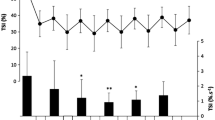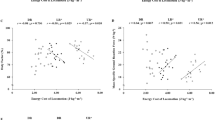Abstract
Purpose
We determined whether running mechanics and leg muscle activity patterns for pre-activation (50 ms prior to foot contact) and loading (first half, second half and entire stance) phases vary between early, late and entire acceleration phases during repeated treadmill sprints.
Methods
Ten male athletes performed three sets of five 5-s sprint accelerations (25-s and 3-min recovery between sprints and sets, respectively) on an instrumented treadmill. Ground reaction forces and surface EMG data (root mean square values of vastus lateralis, rectus femoris, biceps femoris, gastrocnemius medialis, gastrocnemius lateralis and tibialis anterior muscles of the right leg) corresponding to early, late and entire acceleration (steps 2, 4 and 6; steps 8, 10 and 12; and all steps, respectively) have been compared.
Results
Independently of fatigue, vertical and horizontal forces, contact time, step length, and step frequency differed as running velocity increased over different sprint acceleration sections (all P < 0.05). For pre-activation, first half, second half and entire stance phases taken separately, each of the six studied muscles displayed specific main sprint number and analysis section effects (all P < 0.05). However, there was in general no significant interaction between sprint number and analysis section (all P > 0.27).
Conclusion
During repeated treadmill sprints, ground reaction force variables and leg muscle activity patterns can vary between early, late and entire acceleration phases. Identification of neuro-mechanical adjustments across the gait cycle with fatigue, however, did not differ when considering all steps or only a few steps during the early or late acceleration phases.




Similar content being viewed by others
Abbreviations
- BF:
-
Biceps femoris muscle
- EARLY:
-
Early acceleration phase
- ENTIRE:
-
Entire acceleration phase
- GL:
-
Gastrocnemius lateralis muscle
- GM:
-
Gastrocnemius medialis muscle
- GRF:
-
Ground reaction force
- LATE:
-
Late acceleration phase
- RF:
-
Rectus femoris muscle
- RMS:
-
Root mean square
- sEMG:
-
Surface electromyography
- TA:
-
Tibialis anterior muscle
- VL:
-
Vastus lateralis muscle
References
Baur H, Hirschmuller A, Muller S, Gollhofer A, Mayer F (2007) Muscular activity in treadmill and overground running. Isokinet Exercise Sci 15:165–171
Billaut F, Basset FA, Falgairette G (2005) Muscle coordination changes during intermittent cycling sprints. Neurosci Lett 380(3):265–269
Brocherie F, Millet GP, Girard O (2015) Neuro-mechanical and metabolic adjustments to the repeated anaerobic sprint test in professional football players. Eur J Appl Physiol 115(5):891–903
Christian RJ, Bishop DJ, Billaut F, Girard O (2014) The role of sense of effort on self-selected cycling power output. Front Physiol 5:115
Edouard P, Mendiguchia J, Lahti J, Arnal PJ, Gimenez P, Jiménez-Reyes P, Brughelli M, Samozino P, Morin J-B (2018) Sprint acceleration mechanics in fatigue conditions: compensatory role of gluteal muscles in horizontal force production and potential protection of hamstring muscles. Frontiers in Physiology 9:1706
Girard O, Mendez-Villanueva A, Bishop DJ (2011a) Repeated-sprint ability—part I: factors contributing to fatigue. Sports Medicine 41(8):673–694
Girard O, Racinais S, Kelly L, Millet GP, Brocherie F (2011b) Repeated sprinting on natural grass impairs vertical stiffness but does not alter plantar loading in soccer players. Eur J Appl Physiol 111(10):2547–2555
Girard O, Micallef JP, Millet GP (2011c) Changes in spring-mass model characteristics during repeated running sprints. Eur J Appl Physiol 111(1):125–134
Girard O, Brocherie F, Morin J-B, Millet GP (2015a) Neuro-mechanical determinants of repeated treadmill sprints—usefulness of an “hypoxic to normoxic recovery” approach. Front Physiol 6:260
Girard O, Brocherie F, Morin J-B, Degache F, Millet GP (2015b) Comparison of four sections for analysing running mechanics alterations during repeated treadmill sprints. J Appl Biomech 31(5):389–395
Girard O, Brocherie F, Morin J-B, Racinais S, Millet GP, Periard JD (2017a) Mechanical alterations associated with repeated treadmill sprinting under heat stress. PLoS ONE 12(2):e0170679
Girard O, Brocherie F, Morin JB, Millet GP (2017b) Lower limb mechanical asymmetry during repeated treadmill sprints. Hum Mov Sci 52:203–214
Girard O, Bishop DJ, Racinais S (2018) M-wave normalization of EMG signal to investigate heat stress and fatigue. J Sci Med Sport 21(5):518–524
Heiderscheit BC, Chumanov ES, Michalski MP, Wille CM, Ryan MB (2011) Effects of step rate manipulation on joint mechanics during running. Med Sci Sports Exerc 43(2):296–302
Howard RM, Conway R, Harrison AJ (2018) Muscle activity in sprinting: a review. Sports Biomechanics 17(1):1–17
Kyrolainen H, Belli A, Komi PV (2001) Biomechanical factors affecting running economy. Med Sci Sports Exerc 33(8):1330–1337
Mero A, Komi PV (1987) Electromyographic activity in sprinting at speeds ranging from submaximal to supramaximal. Med Sci Sports Exerc 19(3):266–274
Miller JR, Van Hooren B, Bishop C, Buckley JD, Willy RW, Fuller JT (2019) A Systematic review and meta-analysis of crossover studies comparing physiological, perceptual and performance measures between treadmill and overground running. Sports Medicine 49(5):763–782
Morin JB, Samozino P, Bonnefoy R, Edouard P, Belli A (2010) Direct measurement of power during one single sprint on treadmill. J Biomech 43(10):1970–1975
Morin J-B, Sève P (2011) Sprint running performance: comparison between treadmill and field conditions. Eur J Appl Physiol 111(8):1695–703
Morin JB, Samozino P, Edouard P, Tomazin K (2011) Effect of fatigue on force production and force application technique during repeated sprints. J Biomech 44(15):2719–2723
Morin JB, Gimenez P, Edouard P, Arnal P, Jiménez-Reyes P, Samozino P, Brughelli M, Mendiguchia J (2015) Sprint acceleration mechanics: The major role of hamstrings in horizontal force production. Front Physiol 6:404
Nummela A, Rusko H, Mero A (1994) EMG activities and ground reaction forces during fatigued and nonfatigued sprinting. Med Sci Sports Exerc 26(5):605–609
Racinais S, Bishop D, Denis R, Lattier G, Mendez-Villaneuva A, Perrey S (2007) Muscle deoxygenation and neural drive to the muscle during repeated sprint cycling. Med Sci Sports Exerc 39(2):268–274
Suydam SM, Manal K, Buchanan TS (2017) The advantages of normalizing electromyography to ballistic rather than isometric or isokinetic tasks. J Appl Biomech 33(3):189–196
van den Tillaar R, Gamble P (2018) Comparison of step-by-step kinematics and muscle activation of resisted, assisted, and unloaded 30 m sprints in sprinters. Transl Sports Med 1:151–159
Acknowledgements
The authors thank the participants for their maximal efforts and cooperation.
Funding
This work is based on research funded by QNRF (NPRP 4–760–3–217).
Author information
Authors and Affiliations
Contributions
OG, FB, and GPM conceived and designed research. OG and FB conducted experiments. OG, FB, JBM and CH analyzed data. All authors interpreted results of experiments. OG drafted manuscript and prepared figures/tables. All authors edited and revised manuscript. All authors approved final version of manuscript.
Corresponding author
Ethics declarations
Conflict of interest
The authors declare that the research was conducted in the absence of any commercial or financial relationships that could be construed as a potential conflict of interest.
Additional information
Communicated by Toshio Moritani.
Publisher's Note
Springer Nature remains neutral with regard to jurisdictional claims in published maps and institutional affiliations.
Rights and permissions
About this article
Cite this article
Girard, O., Brocherie, F., Morin, JB. et al. Running mechanics and leg muscle activity patterns during early and late acceleration phases of repeated treadmill sprints in male recreational athletes. Eur J Appl Physiol 120, 2785–2796 (2020). https://doi.org/10.1007/s00421-020-04500-8
Received:
Accepted:
Published:
Issue Date:
DOI: https://doi.org/10.1007/s00421-020-04500-8




